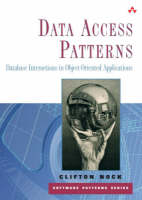
Data Access Patterns
Addison-Wesley Educational Publishers Inc (Verlag)
978-0-321-55562-5 (ISBN)
- Titel ist leider vergriffen;
keine Neuauflage - Artikel merken
Clifton Nock is a senior software architect at PeopleSoft in Denver, Colorado. He spent five years at IBM designing programming interfaces that simplify access to the iSeries operating system and its integrated database and holds nine U.S. patents relating to this work. He has taught several programming courses at the University of Minnesota and presented at technical conferences worldwide. He holds an M.S. in Computer Science from the University of Minnesota.
Preface.
Acknowledgments.
Introduction.
I. DECOUPLING PATTERNS.
The Data Model and Data Access.
Domain Objects and Relational Data.
Decoupling Patterns.
Data Accessor.
Description.
Context.
Applicability.
Structure.
Interactions.
Consequences.
Strategies.
Sample Code.
Related Patterns and Technology.
Active Domain Object.
Description.
Context.
Applicability.
Structure.
Interactions.
Consequences.
Strategies.
Sample Code.
Related Patterns and Technology.
Object/Relational Map.
Description.
Context.
Applicability.
Structure.
Interactions.
Consequences.
Strategies.
Sample Code.
Related Patterns and Technology.
Layers.
Description.
Context.
Applicability.
Structure.
Interactions.
Consequences.
Strategies.
Sample Code.
Related Patterns and Technology.
II. RESOURCE PATTERNS.
Resources and Context.
Resources and Concurrency.
Data Access Resources.
Resource Management.
Resource Patterns.
Resource Decorator.
Description.
Context.
Applicability.
Structure.
Interactions.
Consequences.
Strategies.
Sample Code.
Related Patterns and Technology.
Resource Pool.
Description.
Context.
Applicability.
Structure.
Interactions.
Consequences.
Strategies.
Sample Code.
Related Patterns and Technology.
Resource Timer.
Description.
Context.
Applicability.
Structure.
Interactions.
Consequences.
Strategies.
Sample Code.
Related Patterns and Technology.
Resource Descriptor.
Description.
Context.
Applicability.
Structure.
Interactions.
Consequences.
Strategies.
Sample Code.
Related Patterns and Technology.
Retryer.
Description.
Context.
Applicability.
Structure.
Interactions.
Consequences.
Strategies.
Sample Code.
Related Patterns and Technology.
III. INPUT AND OUTPUT PATTERNS.
Input and Output Operations.
Identity Objects.
Input and Output Patterns.
Selection Factory.
Description.
Context.
Applicability.
Structure.
Interactions.
Consequences.
Strategies.
Sample Code.
Related Patterns and Technology.
Domain Object Factory.
Description.
Context.
Applicability.
Structure.
Interactions.
Consequences.
Strategies.
Sample Code.
Related Patterns and Technology.
Update Factory.
Description.
Context.
Applicability.
Structure.
Interactions.
Consequences.
Strategies.
Sample Code.
Related Patterns and Technology.
Domain Object Assembler.
Description.
Context.
Applicability.
Structure.
Interactions.
Consequences.
Strategies.
Sample Code.
Related Patterns and Technology.
Paging Iterator.
Description.
Context.
Applicability.
Structure.
Interactions.
Consequences.
Strategies.
Sample Code.
Related Patterns and Technology.
IV. CACHE PATTERNS.
Cache Operations and Transparency.
Cached Data.
Cache Patterns.
Cache Accessor.
Description.
Context.
Applicability.
Structure.
Interactions.
Consequences.
Strategies.
Sample Code.
Related Patterns and Technology.
Demand Cache.
Description.
Context.
Applicability.
Structure.
Interactions.
Consequences.
Strategies.
Sample Code.
Related Patterns and Technology.
Primed Cache.
Description.
Context.
Applicability.
Structure.
Interactions.
Consequences.
Strategies.
Sample Code.
Related Patterns and Technology.
Cache Search Sequence.
Description.
Context.
Applicability.
Structure.
Interactions.
Consequences.
Strategies.
Sample Code.
Related Patterns and Technology.
Cache Collector.
Description.
Context.
Applicability.
Structure.
Interactions.
Consequences.
Strategies.
Sample Code.
Related Patterns and Technology.
Cache Replicator.
Description.
Context.
Applicability.
Structure.
Interactions.
Consequences.
Strategies.
Sample Code.
Related Patterns and Technology.
Cache Statistics.
Description.
Context.
Applicability.
Structure.
Interactions.
Consequences.
Strategies.
Sample Code.
Related Patterns and Technology.
V. CONCURRENCY PATTERNS.
Units of Work.
Working Copies.
Concurrency Problems.
Concurrency Solutions.
Concurrency Patterns.
Transaction.
Description.
Context.
Applicability.
Structure.
Interactions.
Consequences.
Strategies.
Sample Code.
Related Patterns and Technology.
Optimistic Lock.
Description.
Context.
Applicability.
Structure.
Interactions.
Consequences.
Strategies.
Sample Code.
Related Patterns and Technology.
Pessimistic Lock.
Description.
Context.
Applicability.
Structure.
Interactions.
Consequences.
Strategies.
Sample Code.
Related Patterns and Technology.
Compensating Transaction.
Description.
Context.
Applicability.
Structure.
Interactions.
Consequences.
Strategies.
Sample Code.
Related Patterns and Technology.
Afterword.
Glossary.
Bibliography.
Index.
| Erscheint lt. Verlag | 14.2.2008 |
|---|---|
| Verlagsort | New Jersey |
| Sprache | englisch |
| Maße | 176 x 243 mm |
| Gewicht | 820 g |
| Themenwelt | Mathematik / Informatik ► Informatik ► Datenbanken |
| Informatik ► Software Entwicklung ► Objektorientierung | |
| Mathematik / Informatik ► Informatik ► Theorie / Studium | |
| ISBN-10 | 0-321-55562-7 / 0321555627 |
| ISBN-13 | 978-0-321-55562-5 / 9780321555625 |
| Zustand | Neuware |
| Haben Sie eine Frage zum Produkt? |
aus dem Bereich


